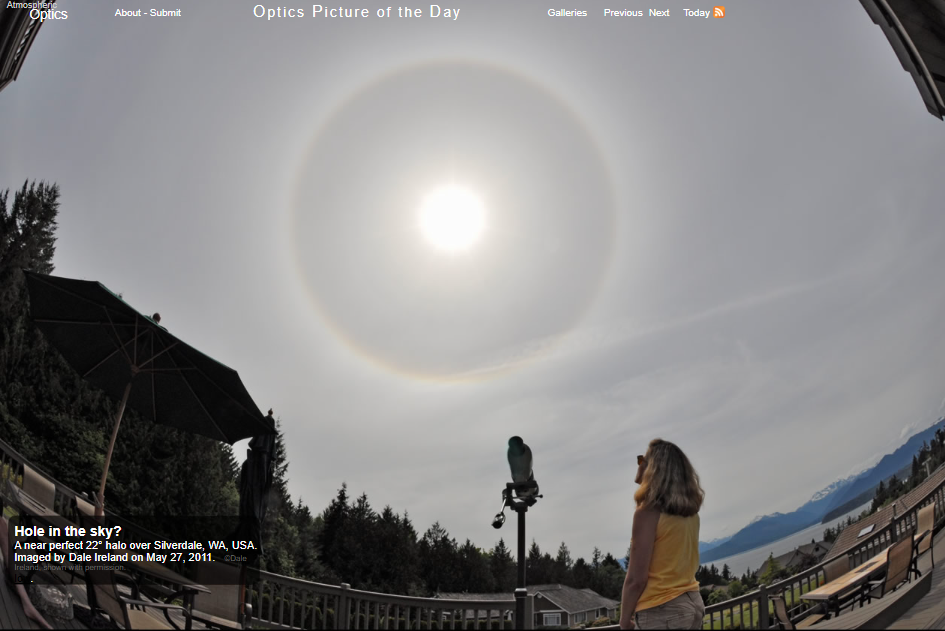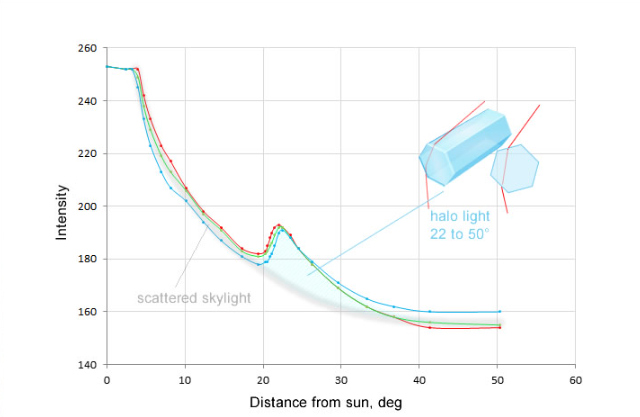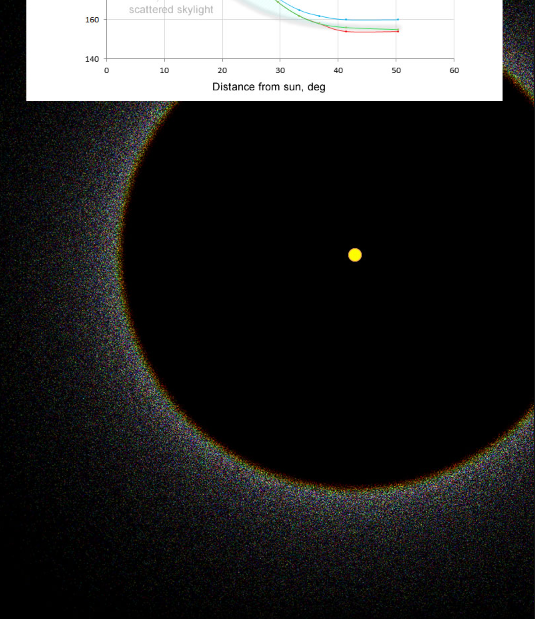OPOD - Is there a hole in the sky?
OPOD - Is there a hole in the sky?
Have you ever noticed a near perfect halo in the sky, where the inner edge appears darker, almost like a hole? This phenomenon is often referred to as "a hole in the sky." But is it really a hole? Let's delve deeper into this fascinating atmospheric optics topic and uncover the truth behind the illusion.
The 22° halo is formed by light rays passing between ice crystal faces inclined at 60 degrees to one another. The minimum angle for deflection of these rays is 22° from the sun, resulting in the formation of a circular halo. Rays refracted through larger angles create a sky brightness outside the inner circle, theoretically extending out to approximately 50° from the sun.
Contrary to popular belief, the sky inside the halo is not actually darker. In fact, measurements taken by Dale Ireland, an avid sky observer, revealed that the sky inside the halo is brighter than outside. This discovery challenges the perception of a hole in the sky and highlights an intriguing illusion.
To better understand the brightness variations within and outside the halo, Ireland conducted red, green, and blue brightness measurements along a radius from the sun to the halo and beyond. The results showed that the sky brightness decreases sharply from the overexposed sun and then experiences a significant bump at approximately 22° where the halo begins. Beyond this point, the brightness gradually decreases again.
The sky's brightness consists of several components:
- Sunlight scattered by air molecules, aerosol and dust particles, and possibly small ice crystals in the cirrus haze. This scattered light decreases smoothly with distance from the sun.
- Halo light refracted by large ice crystals starts to illuminate the sky at approximately 22 degrees from the sun. The measurements clearly indicate the red inner edge of the halo. This excess brightness over the background can be observed up to around 35°, demonstrating that the 22° halo is not a ring but a disk extending outward with decreasing brightness.
- The sky beyond the halo, around 50°, appears more blue than the region within the halo. This disparity could be attributed to Rayleigh scattering by air molecules, which is stronger for blue light than for red light, resulting in the blue color of the sky.
While these findings provide valuable insights into the nature of halos and the composition of the sky, further measurements on different sky images are necessary to determine the generality of this effect.
To visualize the pure halo contribution to the sky brightness, a background image was created using HaloSim ray tracing on a black background. This image reveals the individual glints as dots, accurately representing the halo's presence. In this simulated scenario, there truly is a hole in the sky.
In conclusion, although the sky may appear darker inside real halos, Dale Ireland's measurements have shown that it can actually be brighter within the halo compared to outside. This challenges our perception of a hole in the sky and invites us to reconsider the phenomenon as the "halo hole illusion." Atmospheric optics never ceases to amaze us with its captivating mysteries and intricate interplay of light and ice crystals.

Hole in the sky?
A near perfect 22° halo over Silverdale, WA, USA. Imaged by Dale Ireland on May 27, 2011. ©Dale Ireland, shown with permission.

The sky inside the halo appears darker. It’s often called 'a hole in the sky' – But is it?
The halo has an inner edge at 22° from the sun because that is the minimum angle that light rays passing between ice crystal faces inclined 60 degrees to one another can be deflected. Rays refracted through larger angles form a sky brightness outside the inner circle that theoretically extends out to ~50° from the sun.
No ice crystals within 22° of the sun can glint their halo light towards the observer's eye and the sky there is said to be darker.
However, Dale Ireland measured his image and pointed out that the sky inside the halo is actually brighter than outside – the hole is an illusion.
At right are more red, green and blue brightness measurements taken along a radius from the sun to the halo and beyond. The sky brightness falls off sharply from the sun (overexposed in the image) and there is then a sharp bump where the halo starts at ~22°. The brightness then decreases again.
The sky's brightness has several components:
-
Sunlight is scattered by air molecules, aerosol and dust particles and possibly some very small ice crystals in the cirrus haze. The scattered light decreases smoothly with distance from the sun and is represented in the graph at right by the grey line.
-
Halo light refracted by large ice crystals starts to light the sky at ~22 degrees from the sun (and not before). The measurements clearly show up the halo's red inner edge. The halo light is evident out to ~35° as an excess brightness over the grey line background. This nicely demonstrates that the 22° halo is not a ring but a disk extending outwards with decreasing brightness from 22 degrees.
-
The sky out at 50° is more blue than that within the halo. This could be due to Rayleigh scattering by air molecules which is much stronger for blue light than red and gives us the blue sky. More measurements on other sky images are needed to test the generality or otherwise of the effect.
Finally, the background image is a deliberately course HaloSim ray tracing on a black background to show the pure halo contribution to the sky brightness and the dots representing individual glints. That one really does have a hole.
Inside real halos the sky looks darker but Dale has shown that it can actually be brighter there than outside the halo. Maybe we should rename it the halo hole illusion!

Note: this article has been automatically converted from the old site and may not appear as intended. You can find the original article here.
Reference Atmospheric Optics
If you use any of the definitions, information, or data presented on Atmospheric Optics, please copy the link or reference below to properly credit us as the reference source. Thank you!
-
<a href="https://atoptics.co.uk/blog/opod-is-there-a-hole-in-the-sky/">OPOD - Is there a hole in the sky?</a>
-
"OPOD - Is there a hole in the sky?". Atmospheric Optics. Accessed on April 20, 2024. https://atoptics.co.uk/blog/opod-is-there-a-hole-in-the-sky/.
-
"OPOD - Is there a hole in the sky?". Atmospheric Optics, https://atoptics.co.uk/blog/opod-is-there-a-hole-in-the-sky/. Accessed 20 April, 2024
-
OPOD - Is there a hole in the sky?. Atmospheric Optics. Retrieved from https://atoptics.co.uk/blog/opod-is-there-a-hole-in-the-sky/.